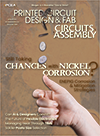Book Reviews
Environmental-Friendly Electronics: Lead-Free Technology
 By Jennie S. Hwang
By Jennie S. Hwang
Electrochemical Publications
31 chapters,
879 pages, list of tables, figures, illustrations and photographs
This first textbook on lead-free soldering is massive—over 800 pages filled with a wide selection of tables, graphs, photographs and great micrographs in chapter 20 that cover intermetalic compounds. The book is filled with plenty of useful information. I say, "Well done!" to the team at Sandia National Laboratories (Albuquerque, NM).
Hwang is well known in the industry and has taught many workshops and seminars at shows such as APEX and NEPCON. She has also worked with several universities and technology groups. Hwang has authored several textbooks that have featured lead-free material, but none have the detail found in her newest endeavor. She also found time to contribute an interview on the SMART Group Web site this year in the Engineering Spotlight.
The book opens with a chapter on current pressures facing environment and issues that are forcing change in manufacturing industry. The second chapter outlines the lead-free technology currently used and the technology that will be required in the future. These chapters set the scene for a discussion concerning environmental policies and the conflicts often found with such policies. An early chapter in the book also looks at existing patents—it's amazing just how many exist for alternative alloys and which companies have filed them.
Hwang has rightly included a chapter on alternatives to solder with a contribution from Ken Gilleo of Cookson Electronics (Foxboro, MA). Anyone who has had the opportunity to sit in on one of Gilleo's workshops knows he has an incredible wealth of experience and his knowledge comes through in the text. The chapter reviews different systems explains advantages and disadvantages. He compares solder and adhesive limits and provides application examples for the reader to consider.
Hwang discusses ternary and binary alloys in separate chapters—each material is discussed by looking at the materials and results on stain and stress measurements, phase transition and wetting issues. To be fair, I must say that you need to be a materials scientist or metallurgist to understand these sections or argue their validity.
My only real criticism would be the lack of a practical "how-to" section that covers assembly issues. Sammy Shina's chapter focuses on the assembly process, with a full debate on an experiment on lead-free soldering but, what the reader is given, are the results of a study, rather a discussion on process and equipment. The chapter does provide a blueprint for companies considering an experiment and how that experiment could be conducted successfully. The book ends with a chapter on comparison, selections and recommendations that give readers the appropriate information to move forward. References are made to solderability issues, tin whiskers and reliability of components.
Don't be intimidated by the daunting number of graphs and tables. Take the time to read a section or two—you'll find this book a good addition to your lead-free library.
Press Releases
- NEOTech Significantly Improves Wire Bond Pull Test Process
- Sat Nusapersada Chooses Siemens' Process Preparation Software to Boost NPI and SMT Line Efficiency
- SIA Praises Finalization of CHIPS Investments for GlobalFoundries Manufacturing Projects
- KYZEN to Spotlight KYZEN E5631, AQUANOX A4618 and Process Control at SMTA Silicon Valley Expo and Tech Forum







